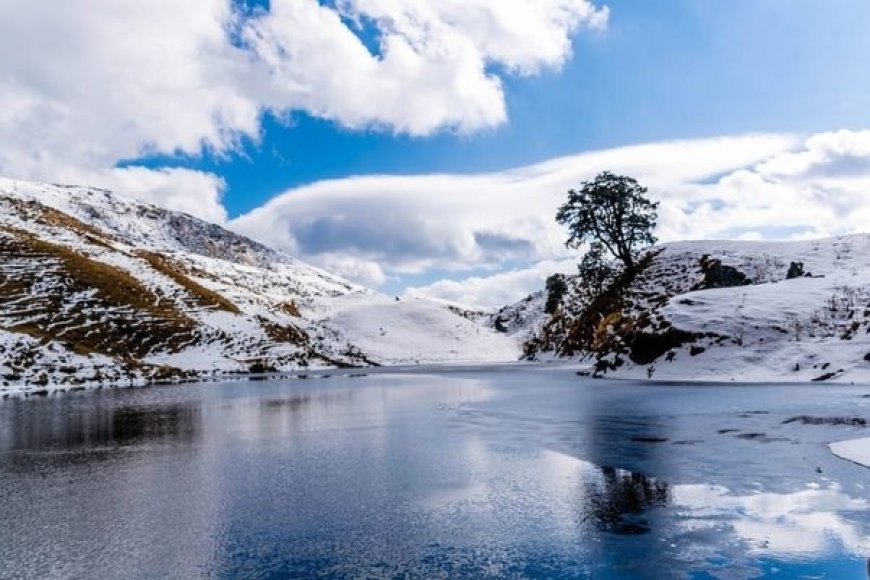A Beginner’s Guide to the Brahmatal Trek
The Brahmatal Trek, nestled in the heart of the Indian Himalayas, is an enchanting journey that beckons both novice and seasoned trekkers. With its serene landscapes, captivating vistas, and relatively moderate difficulty level, it serves as an ideal trek for beginners.

The Brahmatal Trek, nestled in the heart of the Indian Himalayas, is an enchanting journey that beckons both novice and seasoned trekkers. With its serene landscapes, captivating vistas, and relatively moderate difficulty level, it serves as an ideal trek for beginners. If you’re planning your first high-altitude adventure, the Brahmatal Trek should be at the top of your list. This guide aims to provide all the essential information you need to make your trek a memorable and safe experience.
Why Choose the Brahmatal Trek?
The Brahmatal Trek stands out for several reasons:
- Moderate Difficulty: Unlike many high-altitude treks, Brahmatal is accessible for beginners. The trails are well-marked and don’t require technical climbing skills.
- Scenic Beauty: The trek offers stunning views of the Garhwal peaks, including Trishul and Nanda Ghunti. The frozen Brahmatal Lake is a sight to behold in winter.
- Rich Biodiversity: The route passes through beautiful oak and rhododendron forests, which are a haven for bird watchers and nature enthusiasts.
- Cultural Experience: The trek provides a glimpse into the local culture of the Uttarakhand region.
Best Time to Trek
The Brahmatal Trek is accessible year-round, but the best times are:
- Winter (December to February): For those who love snow, this is the perfect time. The trail is blanketed in snow, and the frozen Brahmatal Lake is mesmerizing.
- Spring (March to April): The forests come alive with blooming rhododendrons, adding a burst of color to the landscape.
Brahmatal Trek Package: What to Expect
When looking for a Brahmatal trek package, it’s essential to understand what’s typically included:
- Accommodation: Most packages offer a mix of guest house stays and camping. Ensure your package includes warm sleeping bags and tents suitable for winter conditions if you’re trekking in the cold months.
- Meals: Look for packages that provide nutritious meals throughout the trek. Typically, this includes breakfast, lunch, and dinner.
- Guides and Porters: Professional guides are crucial for ensuring safety and providing local insights. Porters can be a great help in carrying your heavier gear.
- Permits: The trek requires certain permits, which should be arranged by the trekking company.
- Transport: Many packages include transportation from the nearest major city, usually Kathgodam or Rishikesh, to the starting point of the trek.
Detailed Itinerary
Here’s a standard itinerary for the Brahmatal Trek:
Day 1: Arrival in Lohajung
- Arrive at Lohajung, the base camp for the Brahmatal Trek. The drive from Kathgodam to Lohajung takes around 10 hours. Enjoy the scenic journey through winding mountain roads.
Day 2: Lohajung to Bekaltal
- Start your trek from Lohajung to Bekaltal, which is about 6 km and takes 4-5 hours. The trail passes through lush forests of oak and fir. Bekaltal is a beautiful lake surrounded by dense forest, where you’ll camp overnight.
Day 3: Bekaltal to Brahmatal
- The trek from Bekaltal to Brahmatal is around 7 km and takes approximately 6-7 hours. The trail ascends gradually, and you’ll pass through forests and meadows. Brahmatal is a stunning high-altitude lake, perfect for camping.
Day 4: Brahmatal to Brahmatal Top and Back to Brahmatal
- This day involves a trek to Brahmatal Top, also known as Jatropani Peak, which offers panoramic views of the Himalayan ranges. After spending some time at the summit, return to Brahmatal for an overnight stay.
Day 5: Brahmatal to Lohajung via Daldum
- The descent from Brahmatal to Lohajung takes about 8 km. The route via Daldum is scenic, with ample opportunities for photography.
Day 6: Departure from Lohajung
- After breakfast, depart from Lohajung to Kathgodam/Rishikesh, marking the end of the trek.
Essential Gear and Preparation
Preparing for the Brahmatal Trek requires careful planning and the right gear:
- Clothing: Layered clothing is essential for managing the varying temperatures. Include thermal innerwear, fleece jackets, and a waterproof and windproof outer layer. Don’t forget warm gloves, socks, and a hat.
- Footwear: Invest in a good pair of trekking boots with ankle support and a sturdy grip. Break them in before the trek to avoid blisters.
- Backpack: A comfortable, water-resistant backpack with a capacity of 40-50 liters is ideal. Include a rain cover.
- Sleeping Bag: A high-quality sleeping bag rated for sub-zero temperatures is crucial if your Brahmatal trek package doesn’t provide one.
- Trekking Poles: These can help with balance and reduce strain on your knees during ascents and descents.
- First Aid Kit: Include basic medical supplies, blister care, and any personal medications.
- Hydration and Nutrition: Carry a hydration system or water bottles, and pack energy bars, nuts, and other high-calorie snacks.
Physical Preparation
While the Brahmatal Trek is suitable for beginners, it’s still essential to be physically prepared. Here are some tips:
- Cardiovascular Training: Engage in activities like jogging, swimming, or cycling to build stamina.
- Strength Training: Focus on exercises that strengthen your legs, core, and back. Squats, lunges, and planks are effective.
- Flexibility and Balance: Yoga and stretching can improve flexibility and balance, reducing the risk of injury.
- Hiking Practice: If possible, do some practice hikes with a loaded backpack to get used to the physical demands of trekking.
Safety Tips
Safety should always be a priority. Here are some tips to ensure a safe trekking experience:
- Acclimatization: Give your body time to adjust to the altitude. Avoid rushing and take rest days if needed.
- Stay Hydrated: Drink plenty of water to prevent dehydration, which can exacerbate altitude sickness.
- Listen to Your Body: Pay attention to symptoms of altitude sickness, such as headaches, nausea, and dizziness. If you experience these, inform your guide immediately.
- Follow the Guide’s Instructions: Your guide knows the terrain and weather conditions best. Follow their advice and stay with the group.
- Carry a Map and Compass: Even if you have a guide, knowing how to navigate can be crucial in emergencies.
Conclusion
The Brahmatal Trek offers a perfect blend of adventure, natural beauty, and cultural immersion, making it an ideal choice for beginners. By choosing a well-structured Brahmatal trek package, preparing adequately, and respecting the mountains, you can ensure a safe and unforgettable experience. So, lace up your boots, pack your backpack, and get ready to explore the breathtaking landscapes of Brahmatal.
Tags:
What's Your Reaction?
 Like
0
Like
0
 Dislike
0
Dislike
0
 Love
0
Love
0
 Funny
0
Funny
0
 Angry
0
Angry
0
 Sad
0
Sad
0
 Wow
0
Wow
0
























































